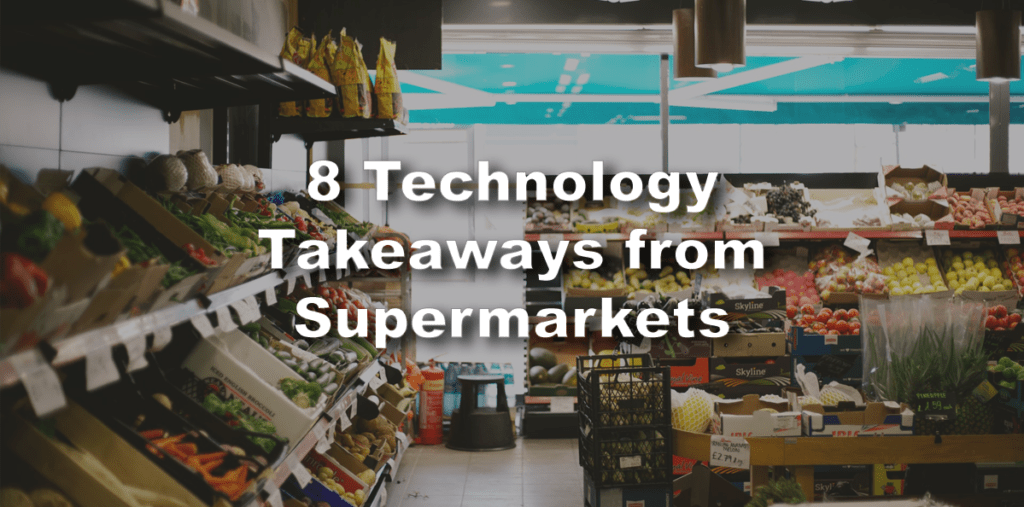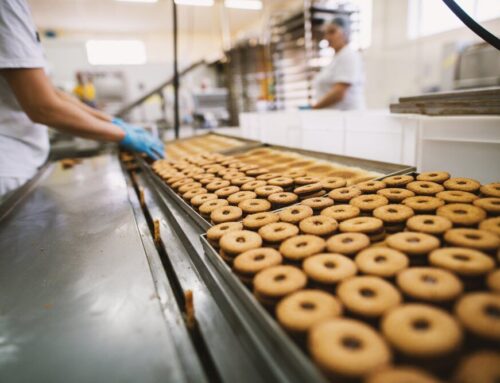Supermarket brands have been among the few winners during the difficult times of the Covid-19 crisis. To keep up with fast-changing government regulations and consumer expectations, they have had to transform their business models, quickly. Pre-pandemic, adopting new technology used to be a long-term strategic decision, and it could take months or years. Today, retailers recognize that technology is a strategic imperative to stay relevant and profitable. Retailers know that they cannot afford to wait. As such, we share with you 8 technology takeaways from the supermarkets.
The innovation UK supermarkets have been introducing is not specific to the grocery industry. Retailers in other segments could leverage the same, or similar, technology to transform the retail experience in their stores. This will also help to future-proof their business.
Below are the 8 ideas to steal from the innovators.
Takeaway #1: ‘Scan pay go’ technology for easier, safer in-store shopping
Sainsbury’s is one of the latest UK supermarkets promoting scan & go technology. With Sainsbury’s SmartShop, customers can use a retailer’s mobile device or run the app on their own mobile. This application allows customers to scan and bag products as they shop in-store. Other UK supermarkets are embracing the scan & go concept. Asda has made mobile scan & go available in all of its almost 600 stores, M&S has doubled the number of stores offering “Mobile Pay Go” to over 100, and Tesco has “Scan as You Shop” available in almost 600 large-format stores.
Consumer uptake of the technology is rising, as it provides clear benefits:
- consumers can shop with little to no staff interaction and reduced risk of staff handling their products
- the shopping process is faster
- it’s easier to avoid contact with other shoppers
- reduce checkout queues
Other factors also play a role in rising usage rates. A common feature of the apps and devices is that they provide a running total of the shopping. These help consumers to stay within their shopping budgets. Several also have a shopping list feature, allowing shoppers to upload a digital shopping list. The digital shopping list will then be rearranged in the order that items appear in the aisles. This is ideal for easing in-store navigation, better managing crowd flows and improving the overall experience.
Takeaway #2: Removing the checkout process
Aldi, the budget supermarket brand, is believed to be developing its own cashier-less Amazon Go rival. The company has put out a call for automatic product recognition technologies, specifically requesting to work with companies who have developed technology that supports automatic recognition of products through in-store cameras, shopping cart sensors or via users’ smartphones.
It comes amid rising demand for frictionless checkouts, with Tesco also competing to bring the technology to market. The company first tested a completely cashless store in 2018 but has yet to roll out on a wider scale.
Amazon Go, meanwhile, is forging ahead with plans to open 10 UK stores without checkouts for paying. In the past, consumers needed an Amazon account and a specific app to access the Amazon Go stores. However, the new technology—“Just Walk Out”—enables shoppers to enter the store and shop using just their credit card. The items picked up by consumers are tracked by in-store cameras and shelf sensors. Once they leave the store, the user’s card is then automatically charged based on the items they took. This is as quick and contactless as a shopping experience can get – for now, at least.
Likewise, in Singapore, we are already seeing such utilisation of the AI system by Octobox and Cheers convenience store for an unmanned store experience.
Takeaway #3: Delivery options that cater to different needs
Throughout the pandemic, Morrisons has put its customers first. Morrisons is committed to reducing the price of essential goods and helping its more vulnerable customers. Recently, it has partnered with retirement village builder McCarthy & Stone to offer a doorstep delivery service to the nation’s retirement communities.
The scheme enables the nation’s older population to order supermarket deliveries over the phone – ideal for those without internet access. It also means they don’t need to visit a grocery store, helping to protect those who are most vulnerable.
For more tech-savvy consumers, partnerships between grocery retailers and delivery services like Amazon Prime and Deliveroo have created the opportunity for ultra-fast delivery options. Amazon and Morrisons are now trialling same-day delivery of chilled, frozen and fresh groceries for Amazon Prime members. Deliveroo is also speeding up the shopping process, allowing shoppers to order essential groceries from retailers including the Co-op, Morrisons and M&S and have them delivered to their doorstep in under 30 minutes.
Takeaway #4: Supporting social distancing and tackling crowds
Social distancing and crowd control are here to stay for the foreseeable future. As such, retailers are exploring innovative ways to control the number of people they have in store.
Aldi’s new automated traffic light system informs customers when they can enter the stores. This automated system is based on individual customer limits that are in line with two-meter social distancing rules. When the light signals green, the doors automatically open and shoppers can enter the store. And when the light is red, the doors remain closed and customers must wait outside until another shopper leaves.
Shopping center operators Intu and Hammerson have taken a similar tact. Intu has repurposed its footfall-tracking technology to monitor and limit the number of shoppers in its centers. Frontline staff are informed when the centre is at maximum capacity so they can instruct shoppers to wait outside until it is safe to enter.
And in Hammerson shopping centres, shoppers can check from home whether it’s safe for them to visit. The Crowd Checker tool uses footfall analysis technology to track the exact number of people in stores in real-time. This provides a live crowd status, letting shoppers know when their local centre is busy and when it’s quiet.
Takeaway #5: Making warehouse operations more efficient
Since the UK lockdown in March, online supermarket delivery firm, Ocado, has received a ten-fold increase in demand for its products. Thus, the company’s robot-powered warehouses have been in overdrive in the last few months. Even when its human workforce is under considerable strain, the robots have been keeping online orders going.
The robots are both delivery and picking & packing machines. In the warehouses, they run around picking up food and bring them to a human who then packs groceries. But Ocado plans to extend these capabilities further. The company owns hundreds of patents which cover a range of automation and technologies. These patents cover from product-picking robots to item scanners that members of staff can wear on their heads. Ocado plans to harness this technology and lease it, too, to supermarkets across the world.
Tesco also has automation in its eyesight, as it prepares for a greater shift to online. The company has plans to open 25 highly automated urban fulfilment centres by 2022. These centers will be located at the back of stores and use the latest technology to improve picking efficiency by a factor of two or three.
Takeaway #6: Using automation to keep on top of cleaning
Asda is the first supermarket in the UK to use autonomous cleaning robots in its stores. This effort comes in a bid to prevent the spread of COVID-19.
These cleaning robots roam around stores during opening hours. They can be ridden by staff and steered with a conventional wheel. Alternatively, they can run by themselves, following a predetermined route around the store. Importantly, the robots can sense when someone or something is blocking their path and stop or move around it.
Asda has also been trialing an automated trolley wash, which disinfects touchpoints without needing employees to clean them. Thus, also reducing the risk of infection for staff.
Takeaway #7: Clamping down on shoplifting
Through a partnership with security solutions provider ThirdEye, Sainsbury’s is testing new concealment detector technology in its stores to catch thieves. The technology uses machine learning to detect when someone takes an item and places it in their pocket or coat. The system will also be able to record the interaction. These interactions will alert the security staff, along with a short clip for inspection purposes.
Sainsbury’s has already trialled an earlier version of the technology successfully: the system has helped prevent almost 6,000 thefts in 20 stores between September 2019 to March 2020.
This latest concealment detector is most probably one of the first-ever commercially available technology of its kind worldwide.
Takeaway #8: Building a sustainable future
Experts fear that the coronavirus pandemic has moved sustainability efforts to the bottom of their agenda. Many retailers have reverted back to widespread single-use plastic bags and more packaging as safety became the top priority. Consumers, too, veered towards packaged food that is less likely to have been handled, or coughed upon, by fellow shoppers.
But consumers are still demanding sustainability. A recent survey found that 55% of people globally have become ‘more concerned’ about the environment as a result of COVID-19. While some sustainability initiatives have unfortunately been put on hold, others have reasserted their commitment to a sustainable future. Supermarkets such as Tesco and Asda, are holding their end to operate more sustainably, and continuing with their plastic reduction programs. Since the beginning of 2020, Tesco has reduced the amount of plastic used to pack chilled fruit juices, saving 410 metric tons annually. Correspondingly, Asda has recently removed 24.5 million plastic forks out of its own-label salads and protein bowls.
In another promising move, 14 major food producers and retailers–including Tesco and Sainsbury’s–have joined the Consumer Goods Forum’s Food Waste Coalition. The Consumer Goods Forum’s Food Waste Coalition aims to halve global food waste by 2030.
While the forum has not yet confirmed specific strategies to reduce food waste, technologies can already be seen in the industry. are already being used in the industry. These technologies include produce-coating technology to extend the shelf life of produce, AI-based technology to help stores better plan and manage fresh inventory, and food rescue apps to prevent excess food from heading straight to landfills.
Conclusion
In the past few months, supermarkets have had to transform quickly while tackling multiple challenges. From crowd controlling measures to heightened hygiene requirements, to inventory complexities caused by panic buying and changed habits. Throughout, they transformed their business, adding technology that would keep consumers’ needs at the centre.
If you also need to transform your business to satisfy and anticipate consumer demands, contact us.
The above article was written by LS Retail on 10 Nov 2020. The original copy can be access here.




